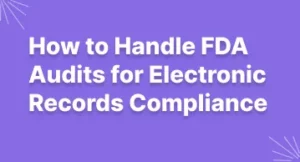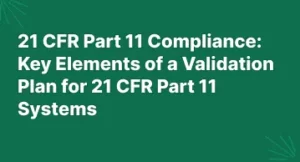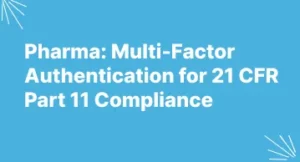Unlock the Benefits of FDA ISO 13485 and 21 CFR Part 820 Harmonization
Introduction to FDA ISO 13485 and 21 CFR Part 820
The U.S. Food and Drug Administration (FDA) is the governing body that regulates medical device manufacturers. Specifically, the FDA requires companies to comply with their 21 Code of Federal Regulations (CFR) Part 820 requirements. Additionally, these companies must also adhere to ISO 13485 standards, which are administered by the International Standards Organization (ISO). Harmonizing these two standards is beneficial for medical device manufacturers as it reduces the cost and time associated with compliance.
Harmonizing FDA ISO 13485 and 21 CFR Part 820 is a process that involves understanding the purpose and function of each standard and then integrating them both into a cohesive system. This guide will provide an overview of the ISO and explain the regulatory framework that governs the harmonization process. We will discuss the benefits of harmonization between the ISO and 21 CFR 820 regulations, provide guidance from the FDA on the harmonization process, demonstrate common issue areas of non-compliance, give real-world examples of harmonization, and review a few resources for further information.
Overview of International Standards Organization (ISO)
The International Standards Organization (ISO) is a global leader in developing and managing international standards for products, services, and systems. ISO was founded in 1947 with the mission of facilitating safe and secure international trade through the development of standards that ensure the consistent safety, quality, and reliability of products, services, and systems.
ISO focuses on the development of international standards and provides technical advice to government organizations, industry, and consumers. All ISO standards are regularly reviewed and updated in order to reflect changes in technology and best practices. The organization also works closely with other national standards bodies to harmonize standards and ensure that they are in line with each other.
ISO 13485 is an international standard developed by the International Standards Organization (ISO) in 2003, specifically designed for medical device manufacturers. It is a voluntary standard that sets out requirements for a Quality Management System (QMS), and is applicable to all organizations involved in the design, production, installation, and servicing of medical devices.
Definition of FDA ISO 13485 and Explaining the Regulatory Framework
The FDA has established a harmonized standard for medical devices. It’s known as FDA ISO 13485 and 21 CFR Part 820, and it is an international agreement essentially between the FDA and the International Standards Organization (ISO). This standard was created in order to ensure the safety and effectiveness of all medical devices.
In order to meet these standards, the FDA requires all medical device companies to obtain certification from the ISO 13485, which is a quality management system standard that provides guidelines on how to manufacture medical products safely and effectively. In addition, 21 CFR Part 820 sets the requirements and regulations for medical device companies to adhere to when manufacturing medical devices. This framework includes design control, corrective and preventive action, management responsibility, production and process control, and more.
Therefore, it is important for medical device manufacturers to comply with both FDA ISO 13485 and 21 CFR Part 820 in order to be in compliance with the FDA and maintain safety and effectiveness of their products.
Analysis of the Benefits of Harmonization Between ISO 13485 and 21 CFR 820
Harmonizing the FDA ISO 13485 and 21 CFR Part 820 standards provide many benefits to organizations with medical device manufacturing processes. First, harmonizing these two standards helps organizations to streamline their operations and make them more efficient by reducing overhead costs in maintaining two separate compliance systems. Second, it encourages companies to increase consistency and accuracy in production, allowing for increased quality control. Lastly, it facilitates worldwide acceptance of their products.
Organizations that harmonize between the FDA ISO 13485 and 21 CFR Part 820 standards will save time and money in the long run. Merging the two systems eliminates duplication of processes and reduces paperwork. Companies can create consistent and effective procedures that are adapted to fit the needs of the organization as a whole. This provides consistency throughout the business which leads to better product quality and fewer mistakes.
By harmonizing the two standards, organizations are able to ease regulatory burdens while still meeting international product safety requirements. This allows them to quickly and efficiently get their products to market, as well as receive approvals from regulatory authorities around the world. Harmonization also makes inquiries into product safety easier by simplifying the process for regulatory organizations to review and approve products.
Ultimately, harmonization between FDA ISO 13485 and 21 CFR Part 820 allows organizations to reduce or even eliminate instances of non-compliance, increase product safety, improve efficiency, and reduce overall costs. By combining the two standards, organizations can reap the rewards of harmonization without sacrificing the principles of safe and compliant production.
Guidance from the FDA on Harmonization of ISO 13485 and 21 CFR 820
The U.S. Food and Drug Administration (FDA) provides guidance in harmonizing ISO 13485 and 21 CFR 820. According to the FDA, harmonization between the two standards should be achieved “by designing processes, procedures, and practices that meet the requirements of both sets of standards.”
In 2017, the FDA released a document titled “Guidance for Industry: Harmonization of ISO 13485 and 21 CFR 820,” which outlines areas of compliance that manufacturers should consider when bringing their Quality System into conformance with the two standards. According to the guidance document, some of the key areas of harmonization include:
- Document control
- Management review
- Auditing
- Nonconforming products
- Corrective and preventive actions
- Purchasing controls
- Internal training
The FDA also recommends that manufacturers adopt the process approach to quality management in order to ensure compliance with both ISO 13485 and 21 CFR 820. The process approach includes the development of Quality Management System (QMS) procedures that are tailored to the individual needs of the organization.
Commonly Occurring Issues of Non-Compliance
One of the most common compliance issues that arise from a lack of harmonization between FDA ISO 13485 and 21 CFR Part 820 standards is the failure to create an appropriate quality management system. This can include improper documentation, audit trails, training, and more. Without a proper quality system in place, organizations are unable to prove or guarantee that their products meet the necessary safety and efficacy standards.
Another common issue is the failure to maintain comprehensive and accurate records during the entire product life cycle. This includes issues such as filing incomplete information, failing to update documents, or using outdated material. Organizations must ensure that all records are up to date in order to maintain regulatory compliance.
Finally, inadequate communication between various departments can lead to discrepancies in quality control, leading to non-compliance with FDA regulations. It’s important for organizations to ensure that everyone involved in the production of a product is aware of the relevant standards and regulations to avoid any violations.
Real World Examples of Harmonization Between ISO 13485 and 21 CFR 820
Harmonization between ISO 13485 and 21 CFR 820 is essential to ensure medical device manufacturers comply with both international and US quality management standards. Here we provide some real world examples to demonstrate the practical applications of harmonization between these two regulations.
For example, ISO 13485 establishes requirements for a Quality Management System (QMS) for medical device manufacturers, while 21 CFR 820 sets the standards for documentation and record keeping relating to the QMS. One example of harmonizing these two systems is by preparing and maintaining timely and accurate records that fulfill the requirements of both ISO 13485 and 21 CFR 820. This can be achieved by making sure that all documents related to the QMS are maintained according to both regulations and are kept up to date.
Another example of harmonizing these two regulations is by developing processes to ensure that the design and development of medical devices meets both ISO 13485 and 21 CFR 820 requirements. This involves establishing processes for verification, validation, and risk management, which must be done in accordance with both regulations. By harmonizing these two regulations, manufacturers can ensure that their medical device design and development processes are compliant with both sets of standards.
Finally, harmonization between ISO 13485 and 21 CFR 820 also applies to product monitoring and maintenance. This means that manufacturers must have processes in place to ensure that their medical devices continue to meet both regulations throughout the entire product lifecycle. These processes might include routine inspections, testing, and corrective actions if necessary, all of which must be carried out in accordance with both ISO 13485 and 21 CFR 820.
By following these harmonization guidelines, medical device manufacturers can ensure that their products comply with both ISO 13485 and 21 CFR 820 standards.
Closing Summary
The harmonization of ISO 13485 and 21 CFR 820 is essential for those looking to achieve compliance with FDA regulations. Both standards provide key guidance on regulatory requirements, quality management systems (QMS), and general concepts of quality control. The benefits of harmonization include improved efficiency and effectiveness of the QMS, resolution of conflicting requirements, and improved communication between company and regulator. Harmonizing these two standards is not always easy, but with the right guidance and resources, it can be a successful endeavor.
Issues with non-compliance often arise due to misunderstandings or misinterpretations of the standards. To avoid such issues, it is important to continually review and update adopted processes, provide training to personnel, and ensure that all documentation is accurate and complete. By doing so, companies will be able to maintain compliance with FDA regulations and improve their quality management system.
Real-world examples of ISO-FDA harmonization can help companies understand how to properly harmonize their own processes. Such examples can serve as a reference point for identifying areas of need and developing an actionable plan for implementation. With the right guidance, understanding regulatory requirements, and taking preventative measures, companies can achieve harmonization between ISO 13485 and 21 CFR 820.
Glossary of Relevant Terms and Abbreviations
When talking about FDA ISO 13485 and 21 CFR Part 820 harmonization, there are a few essential terms and abbreviations to keep in mind.
- ISO: International Standards Organization
- FDA: Food and Drug Administration
- CFR: Code of Federal Regulations
- 13485: An international quality management systems standard for medical devices industry
- 820: 21 CFR Part 820 is the Quality System Regulation issued by the FDA
Resources for Further Information
In closing, there are several helpful resources available for anyone wishing to learn more about harmonization between FDA ISO 13485 and 21 CFR Part 820. The following sources provide a starting point:
- The U.S. Food and Drug Administration Website, which contains both an overview of ISO 13485, as well as a comprehensive guide to 21 CFR Part 820.
- The International Standards Organization (ISO) Website, which provides an extensive library of technical standards.
- The MITRE Corporation Website, which offers in-depth analyses of the harmonization process.
These websites provide an invaluable resource for understanding the harmonization process between FDA ISO 13485 and 21 CFR Part 820.
The conclusion of this guide is one that highlights the importance of harmonization between FDA ISO 13485 and 21 CFR Part 820. Harmonization is necessary to ensure compliance with applicable regulations, both domestically and internationally. It is critical that companies understand the nuances of both standards and the importance of harmonizing them in order to stay compliant. The goal of this guide has been to provide readers with an overview of how harmonization between FDA ISO 13485 and 21 CFR Part 820 can be achieved. We hope that we have provided readers with enough information to help them understand the implications of harmonizing these two standards and how their organization might go about doing so.
Editorial Review and Referencing
In order to ensure the accuracy of information, the guide must go through a thorough editorial review process. This means that all facts, figures, and statements must be checked for their accuracy.
The sources and references used in writing the article must be properly credited in order to give credit to the original author. This will allow readers to follow up on the source material to gain more information about the subject matter.
In addition, all information should be properly cited and attributed to its source when possible. The citation should include the name of the source, its date of publication, and its URL (if available).
Finally, the guide must also be proofread for any typos or grammatical errors. A good editor should be able to spot any errors and make corrections before the guide is published.
Frequently Asked Questions about FDA ISO 13485 and 21 CFR Part 820 Harmonization
1. What is FDA ISO 13485?
FDA ISO 13485 is a harmonized medical device management system that combines International Standards Organization (ISO) 13485 and U.S. Food and Drug Administration (FDA) 21 CFR Part 820 regulations. These standards aim to ensure quality of manufactured products, medical device safety, and adherence to governmental rules and regulations.
2. What is ISO 13485?
ISO 13485 is an international standard for Quality Management Systems specific to the medical device industry. It outlines requirements and expectations necessary for design, manufacture, installation, and servicing of medical devices to ensure a safe global environment.
3. What is 21 CFR Part 820?
21 Code of Federal Regulations (CFR) Part 820 outlines the standards for design, manufacture, packaging, labeling, storage and handling, installation, and servicing of medical devices in the United States. It is enforced by the FDA and applies specifically to medical devices registered in the United States market.
4. What are the benefits of harmonizing ISO 13485 and 21 CFR 820?
Harmonizing FDA/ISO 13485 versus 21 CFR 820 has many potential benefits. These include a streamlined and efficient registration process, cost savings due to fewer audits, global product certification management, and increased stakeholder confidence that a safely-manufactured product will reach the market.
5. What guidance does the FDA provide for harmonization of ISO 13485 and 21 CFR 820?
The FDA encourages manufacturers to harmonize their Quality Management System (QMS) with both ISO and regulatory standards. As such, they have provided guidance on using specific methods for combined certification assessments. These include the “no gaps” enhanced combination approach and the “gap closure”combination assessment.
6. What are some commonly occurring issues of non-compliance?
Commonly occurring issues of non-compliance include failure to maintain clinical data, lack of appropriate detailing regarding product specifications, problems with post-market surveillance, and inadequate follow-ups on product feedback.
7. What are some real world examples of harmonization between ISO 13485 and 21 CFR 820?
Examples of harmonization between ISO 13485 and 21 CFR 820 include Roche Diagnostics and Covidien Medical Products, who have used the no gaps enhanced combination method to ensure a unified, streamlined management system. These companies are able to successfully deliver safe, high-quality medical products to the market without additional cost and time pressures.





